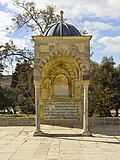Dome of Yusuf
The Dome of Yusuf (Arabic: قبة يوسف Qubbat Yūsuf) is a free-standing domed structure on the Temple Mount, located south of the Dome of the Rock.
It was built by Saladin (born Yusuf) in the 12th century, and has been renovated several times.[1][2][3] It bears inscriptions from the 12th and 17th centuries: one dated 1191 in Saladin's name, and two mentioning Yusuf Agha, possibly a governor of Jerusalem or a eunuch in the Ottoman imperial palace.[1][4][5]
Description
[edit]A rectangular semi-enclosed structure resembling an aedicule,[6] the Dome of Yusuf sits upon a solid stone wall and is supported by three pointed open arches. On the northern face of the southern wall, there are stone carvings and a marble-faced blind niche. The exterior of the dome is covered in lead sheeting, and the interior is decorated with a ribbed pattern.[4][5]
The structure has three inscriptions:
- The prominent inscription on the lower panel, a green naskh Arabic text, is from 1191 (during the Ayyubid dynasty). It calls Saladin by his kunya Abū’l-Muẓaffar ("father of the Triumphant") and his personal name Yūsuf.[N 1] It also mentions an emir, al-Asfahasalar Sayf ad-Din Ali bin Ahmad (al-Asfahsalar Ali bin Ahmad al-Hikkari), for having supervised the construction of a defensive trench.[7]
- Two small, unpainted inscriptions are on the façade's spandrels (above the arch). They are in two different languages, together forming a bilingual epigraphic text. Both panels end with "1092" in Eastern Arabic numerals (١٠٩٢), which is the Hijri year that overlaps partly with 1682 CE.[8]
The white central panel inside the niche is blank.
Environs
[edit]It is one of several structures jutting out of the southern end of the raised platform (terrace) of the Dome of the Rock. The Dome of Yusuf is between the Summer Pulpit (Minbar of Burhān ad-Dīn) and the an-Naḥawiyya Dome (Grammarians' Dome). To their east, one sees the main southern colonnade (mawāzīn).
The less-ornamental Dome of Yusuf Agha is a separate building, located in a plaza in the south of the compound.
References
[edit]- ^ Saladin's name ʾAbū al-Muẓaffar Yūsuf ibn Ayyūb (أبو المظفر يوسف بن أيوب) is in the fourth line, starting in the middle.
- ^
The right (west) inscription:[8]
- "The superintendent Ali Agha has built this – that the reward should all fall on Yusuf Agha. On seeing it, the Oracle Hatif pronounced its date: Muharram of the year 1092 (AH)."
- Inscribed Ottoman Turkish text:
- Transliteration: Yapdı Nazır Ali Ağa bunu / Ol ecri Yusuf Ağayı tamam / Dedi Hatif Kurnaci tarihin / Oldu bin doksanikide tamam / Muharrem sene 1092.
- ^
The left (east) inscription:[8]
- "This [dome] has been built out of piety on behalf of Yusuf, / the agha of the Abode of Supreme Felicity [Istanbul], through his perfect piety. / We are presented with it in the phrasing (chronogram) regarding its construction. / Ali has built it [the dome], but the reward for it returns to Yusuf. / Muharram of the year 1092 (AH)."
- Inscribed Arabic text:
- ^ a b Carole Hillenbrand (2000). The Crusades: Islamic perspectives (Illustrated, reprint, annotated ed.). Routledge. p. 191. ISBN 978-0-415-92914-1.
a monumental inscription dated 587(AH)/1191 in [Saladin's] name on the Dome of Joseph [Qubbat Yusuf] on the Haram esplanade: 'the victorious king, the probity of this world and of [true] religion, the Sultan of Islam and of the Muslims, the servant of the two noble sanctuaries and of Jerusalem.'
- ^ Necipoğlu, Gülru (1998). Muqarnas: An Annual on the Visual Culture of the Islamic World (Illustrated, annotated ed.). BRILL. p. 73. ISBN 978-90-04-11084-7.
- ^ Myriam Rosen-Ayalon (2006). Islamic art and archaeology in Palestine (Illustrated ed.). Left Coast Press. p. 97. ISBN 978-1-59874-064-6.
- ^ a b [dead link] Qubbat Yusuf Archived August 5, 2011, at the Wayback Machine Archnet Digital Library.
- ^ a b [dead link] Al-Aqsa Guide Friends of al-Aqsa 2007. Archived December 20, 2008, at the Wayback Machine
- ^ Hillenbrand, Robert (2000). Auld, Sylvia (ed.). Ottoman Jerusalem. London: British School of Archaeology in Jerusalem. p. 16. ISBN 978-1-901435-03-0.
[…] two structures erected by Yusuf Agha in 1681 – the Qubbat Yusuf (an open-plan aedicule) and the Qubbat Yusuf Agha (a closed domed square) – clearly suggest that, despite the identical terminology, different forms connoted different functions in Jerusalem at that time.
- ^ "Marble inscription panel". Museum with No Frontiers.
- ^ a b c Tutuncu, Mehmet (2006). Turkish Jerusalem (1516-1917): Ottoman Inscriptions from Jerusalem. SOTA.
The name Qubbat Yusuf refers not only to the builder Yusuf Agha but it also refers to Salahaddin. He is referred to in the inscription as Abulmuzaffer Yusuf.
A version is here, p. 10-12, but it misspells "piety" (should be التقوى) as التققى.
31°46′38.60″N 35°14′07.17″E / 31.7773889°N 35.2353250°E
External links
[edit] Media related to Dome of Yusuf at Wikimedia Commons
Media related to Dome of Yusuf at Wikimedia Commons- 360-degree view from under the dome
- A 19th-century map of the area. It is labelled lowercase n. The author, Ermete Pierotti, claims it was where Saladin prayed after winning the Siege of Jerusalem: "où Saladin fit sa premiere prière après la prise de Jérusalem".



